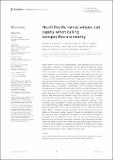Files in this item
North Pacific minke whales call rapidly when calling conspecifics are nearby
Item metadata
| dc.contributor.author | Martin, Cameron R. | |
| dc.contributor.author | Guazzo, Regina A. | |
| dc.contributor.author | Helble, Tyler A. | |
| dc.contributor.author | Alongi, Gabriela C. | |
| dc.contributor.author | Durbach, Ian N. | |
| dc.contributor.author | Martin, Stephen W. | |
| dc.contributor.author | Matsuyama, Brian M. | |
| dc.contributor.author | Henderson, E. Elizabeth | |
| dc.date.accessioned | 2022-09-06T09:30:15Z | |
| dc.date.available | 2022-09-06T09:30:15Z | |
| dc.date.issued | 2022-08-22 | |
| dc.identifier | 281195447 | |
| dc.identifier | 70eaaf37-a86e-490c-a6c6-27392caaae51 | |
| dc.identifier | 85137891420 | |
| dc.identifier | 000872570000001 | |
| dc.identifier.citation | Martin , C R , Guazzo , R A , Helble , T A , Alongi , G C , Durbach , I N , Martin , S W , Matsuyama , B M & Henderson , E E 2022 , ' North Pacific minke whales call rapidly when calling conspecifics are nearby ' , Frontiers in Marine Science , vol. 9 , 897298 . https://doi.org/10.3389/fmars.2022.897298 | en |
| dc.identifier.issn | 2296-7745 | |
| dc.identifier.other | Jisc: 584528 | |
| dc.identifier.other | ORCID: /0000-0003-0769-2153/work/118800100 | |
| dc.identifier.uri | https://hdl.handle.net/10023/25953 | |
| dc.description | Funding: This research was supported by Commander, U.S. Pacific Fleet (Code N465JR, Award Number N0007020WR0EP8F) and tool development utilized for this analysis was supported by the U.S. Navy’s Living Marine Resources Program (Award Number N0002520WR0141R). | en |
| dc.description.abstract | North Pacific minke whale (Balaenoptera acutorostrata) boing calls are commonly detected in Hawaiian waters. When producing boing vocalizations, minke whales seem to be in one of two calling behavioral states. Most often minke whales produce boings with inter-call intervals of several minutes, but sometimes minke whales call rapidly with inter-call intervals of less than a minute. Since minke whales are difficult to detect visually, cue-rate-based density estimation using passive acoustic monitoring has been proposed. However, the variables that influence cue rate or calling rate are poorly understood in most whales, including minke whales. We collected passive acoustic recordings from 47 bottom-mounted hydrophones at the Pacific Missile Range Facility’s instrumented range off the coast of Kauaʻi, Hawaiʻi to test the hypothesis that minke whales call more rapidly when closer in proximity to other calling conspecifics. A total of 599 days of data were recorded between August 2012 and July 2017 and were automatically post-processed to detect, classify, and localize calls. Localized calls were grouped into tracks and manually validated, resulting in 509 individual tracks composed of 36,033 calls within a 16 x 39 km focal study area. Tracked minke whales exhibited a strong bimodal call rate with means of one call every 6.85 min (σ= 2.54 min) and 0.63 min (σ= 0.36 min). We ran hidden Markov models to quantify the relationship between call rate and the distance to the nearest calling conspecific. Overall, the probability of the higher call rate occurring increased as the distance to the nearest conspecific decreased, and the probability of the lower call rate occurring increased as the distance to the nearest conspecific increased. We also examined individual track data and found that minke whales may also exhibit other responses (i.e. increased speed, changes in heading, and cessation of calling) when calling conspecifics are nearby. These findings provide new information about minke whale calling behavior in what is likely a breeding area. | |
| dc.format.extent | 12 | |
| dc.format.extent | 5480609 | |
| dc.language.iso | eng | |
| dc.relation.ispartof | Frontiers in Marine Science | en |
| dc.subject | Minke whale (Balaenoptera acutorostrata) | en |
| dc.subject | Inter-call interval (ICI) | en |
| dc.subject | Calling rate | en |
| dc.subject | Cue rate | en |
| dc.subject | Bioacoustics | en |
| dc.subject | Passive acoustic monitoring | en |
| dc.subject | Animal behavior | en |
| dc.subject | Marine ecology | en |
| dc.subject | GC Oceanography | en |
| dc.subject | QL Zoology | en |
| dc.subject | DAS | en |
| dc.subject | SDG 14 - Life Below Water | en |
| dc.subject | MCC | en |
| dc.subject.lcc | GC | en |
| dc.subject.lcc | QL | en |
| dc.title | North Pacific minke whales call rapidly when calling conspecifics are nearby | en |
| dc.type | Journal article | en |
| dc.contributor.institution | University of St Andrews. Arctic Research Centre | en |
| dc.contributor.institution | University of St Andrews. School of Mathematics and Statistics | en |
| dc.contributor.institution | University of St Andrews. Centre for Research into Ecological & Environmental Modelling | en |
| dc.identifier.doi | https://doi.org/10.3389/fmars.2022.897298 | |
| dc.description.status | Peer reviewed | en |
This item appears in the following Collection(s)
Items in the St Andrews Research Repository are protected by copyright, with all rights reserved, unless otherwise indicated.

